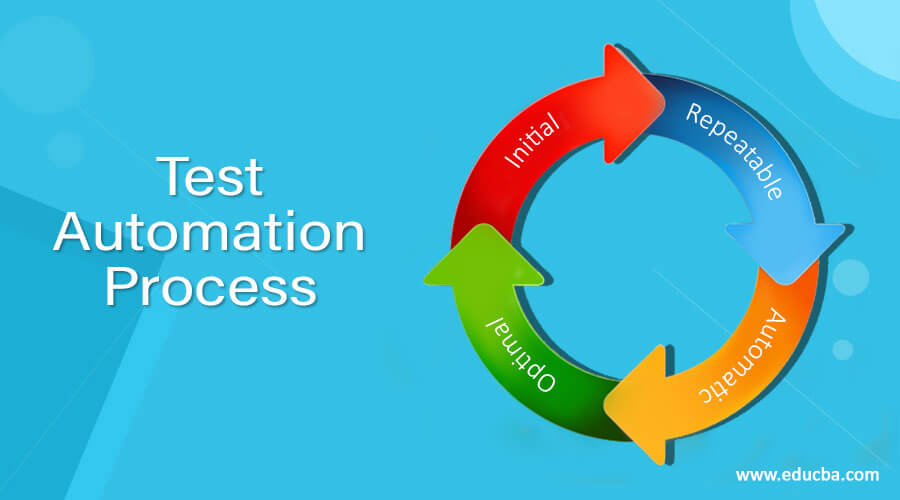Updated April 10, 2023
Introduction to Test Automation Process
Test automation process refers to the activities that automate the engineering tasks and operations in software testing process by using well-defined strategies and systematic solutions. It reduces the manual testing activities and repeated the test operation using a systematic solution to achieve better testing coverage. Increases the quality and effectiveness of the software testing process by achieving pre-defined adequate test criteria in a limited duration. In enterprise-oriented test automation, the emphasis is to automate the enterprise-oriented test process so that it can be reused to test different product lines and projects in an organization. In product-oriented test automation, the emphasis is on a specific software product line so that it can be used in testing its related testing activities. In project-oriented test automation, the emphasis is on one particular project and its corresponding test process.
Test Automation Process
There are total 5 steps involved in test automation – Plan test automation, Design test automation, test toll development, Test tool deployment, and Review and evaluation. Let’s discuss these steps in detail.
Step 1: Plan test automation
The Major task here is to make the plan that specifies the identified test automation tasks, objectives, requirements, strategies, schedule, and budget.
Step 2: Design the test automation
In this step, we find out the detailed test automation solutions that are needed to achieve the major objectives and hence meet the given requirements in the test automation process.
Step 3: Test tool development
In this step, the designed test automation solutions are developed and tested to make sure that the developed tools are reliable and reusable with good documentation.
Step 4: Test tool deployment
The developed test tools are introduced and deployed into the project or onto a product line. This step also provides user training.
Step 5: Review and evaluation
Whenever a new tool is deployed a review is conducted to identify if there are any issues or limitation and evaluated its provided features. The review results provide feedback to the test automation group to identify further improvement.
Test Automation Maturity Model
There are four levels in test automation maturity model – Initial, Repeatable, automatic, and optimal. Let’s discuss these levels one by one in detail.
Level 1: Initial
A software automation test process at this level provides engineers with systematic solutions and tools to create, update and manage all types of software test information such as test cases, test data, test results, test procedures, test scripts, and problem reports. No systematic solutions and tools are available to support the engineers in teat design, test generation, and test execution.
Level 2: Repeatable
This level not only provides engineers with tools to manage various software test information but also provides systematic solutions for software test execution. These solutions helps engineer to use a systematic approach to execute tests and validate the test results. But no systematic solutions and tools are available to support test engineers in test design, test coverage measurements, and test generation.
Level 3: Automatic
This level does not only provides engineers with test management and test execution tools buy also provides additional systematic solutions to generate software tests. These solutions helps engineer to generate black box or white box software tests. But, no systematic solutions are available to support test engineer in measuring the test coverage of test process.
Level 4: Optimal
This level not only provides systematic solutions to manage test information, execute tests, and generates test but also provides additional systematic solutions to measure test coverage. This primary advantage of achieving this level is to help engineers understand the current coverage of a test and identify the test coverage issues.
Issues with Test Automation Process
Some of the issues with test automation process are as follows
- Impracticable goals and expectations.
- Poor manually performed software testing.
- Organizational issues.
- Late involvement of software test automation in software development life cycle.
- Lack of good understanding and experience of software test automation.
Tools used for Test Automation Process
There are various tools used for test automation. Based on the test automation process, the tools are classified into categories which are as follows:
- Test information management: Systematic solutions and tools support test engineer to create, update and maintain test information like test cade, test scripts, test results, test data, and identified problems.
- Test execution and control: Systematic solutions and tools help the engineer to execute tests and validate test results.
- Test coverage analysis: Systematic solutions and tools analyze the test coverage during test process.
- Test generation: Systematic solutions and tools generate program tests in an automatic way.
- Software simulators: Programs are developed to stimulate the function and behavior of the system for an under test program.
- Performance testing and measurement: Systematic solutions and tools support performance testing and measurement.
- Regression testing: Test tools support the automation performance of regression testing.
Conclusion
Test automation process frees engineers from tedious and repeated manual testing operations. Fasten the software testing process and hence reduce the software testing cost and time required during the software development life cycle. Here in this article, we have discussed the test automation process in a stepwise manner. Hope you enjoyed the article.
Recommended Articles
This is a guide to Test Automation Process. Here we discuss the 5 steps involved in test automation, Test Automation Maturity Model, and Tools used for Test Automation Process. You may also have a look at the following articles to learn more –

